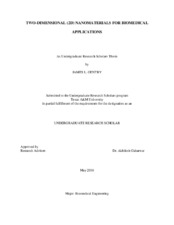| dc.description.abstract | As regenerative medicine progresses, the need for non-cytotoxic and bioactive tissue scaffolds becomes increasingly urgent. To address this need, a PEG-based hydrogel crosslinked by molybdenum disulfide (MoS2) nanoassemblies was developed. The 2D nanoflakes that form these assemblies are rich with defects, specifically elemental vacancies, that easily conjugate thiolated ligands. MoS2 has been extensively studied for application in electrochemistry, nanoelectronics, lubricants, and biosensing, yet studies describing their role in the biomedical field are rare. Using a multi-arm PEG-thiol, this defect-mediated reaction is exploited to form a mechanically stiff hydrogel. By varying reactant ratios, several samples of MoS2 nanoassemblies have been synthesized using a hydrothermal method. The structure and defect content of each sample was characterized to determine the optimal nanoassembly for gelation. This work discusses the chemical and morphological characterizations and the mechanical properties of the developed PEG-MoS2 gels. The physiologically relevant properties and behavior of the hydrogel indicate that it is suitable for further exploration in tissue engineering applications. | en |


